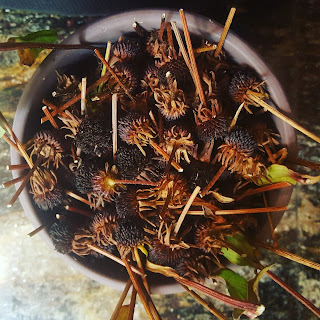Monsanto's Terminator Technology, Seed Saving, and Our Food and Flower Freedom
Seed saving is a conservation technique that I've practiced for many years. More and more gardeners are doing the same. Seed banks like the Norwegan Svalbard Global Seed Vault and India's Navdanya are working on a large scale to preserve seed biodiversity for future generations, and break the back of patent-driven, profit-driven corporations like Monsanto.
By saving seeds, small-scale gardeners like myself and large seed bank interests are working to protect ancient, heirloom varieties of food and flower crops that could easily be lost to a world of genetic engineering.
Control over seed is a nasty business. Monsanto plays Frankenstein when it places foreign genes into plant cells to prevent insects and weeds (which GMO crops are failing to do, instead creating terrifying superbugs and superweeds). Even Monsanto has admitted that their GMO crop experiments have failed.
Seed control traps and runs into debt farmers whose monocrops have become dangerously vulnerable, forcing them to apply poisonous weed- and insect-killing products - sold by Monsanto's evil cohort, DuPont - which we then eat and feed to our children and animals.
Monsanto has even patented sterile seeds - seeds that produce viable plants but with barren seeds that will never grow. The Convention on Biological Diversity has banned their use, but Monsanto will keep fighting for the legal right to enforce sterile seeds on farmers and gardeners, leaving us powerless to preserve seeds for future use. Plants would cease to evolve (plants evolve, just like animals). And once these mutant seeds are out of the bag, there's no going back.
If sterile seeds make their way into agriculture, we would have to buy new, patented, genetically-modified seeds from biotech firms each year. Agricultural biodiversity would be seriously threatened, if not eliminated. Gone would be our autonomy over the food we grow. Our ecosystem would collapse. There is absolutely nothing more terrifying to me than to be beholden to a ruthless corporate giant like Monsanto for the very stuff of life - seeds.
This weekend, we started our seed saving ritual. We collected and organized seeds from our Black-Eyed Susans (from a variety I took from my mother's gardens many years ago), morning glories (also from my mother's gardens of old), scarlet runner bean, sunflower, pepper, burapa pepper, sage, basil, and lettuce. In the coming weeks, we'll collect and organize the rest.
I've included with this blog post a photo of our Black-Eyed Susan seed heads from this weekend. I think they're utterly beautiful. Each tiny seed head was broken apart, seeds were gathered and separated from husk, then bagged and bottled and labeled. It took a long time.But next year, if we're all alive, we'll be planting these seeds and producing more of Mom's favorite heirloom, GMO-free flowers.
There will be tons of seedlings to give away and disseminate to gardens far and wide. Biotech firms like Monsanto wish gardeners like us would stop this and just buy their terminator technology. Sorry. These flowers have been and will always be - as long as I'm growing them - earth-created, not lab-created. There's absolutely no room for transgenes and lab-created food in this girl's garden.
Barbie xo


